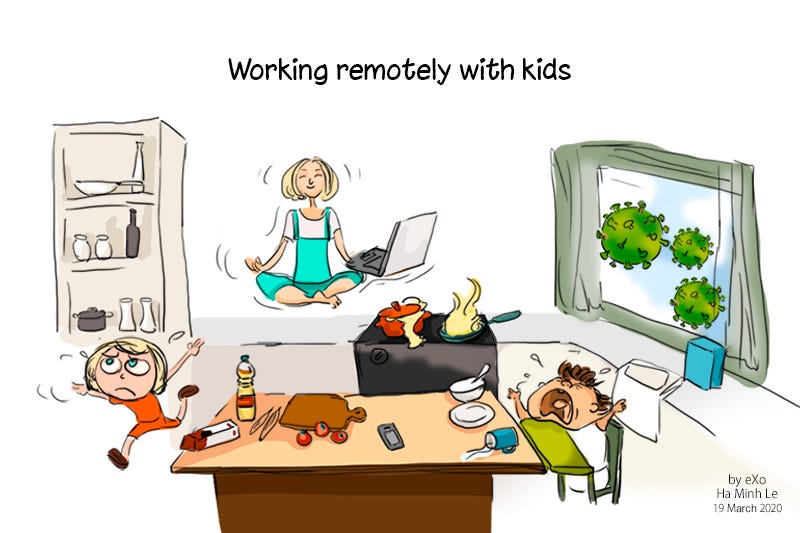Between Apple’s director of A.I. quitting due to RTO and AirBnb’s new remote work policy, it’s clear the future of WFH vs. RTO is really not going to be the same.
The Great Resignation, never felt like just a great reshuffle to me. It felt like it had layers of an identity crisis with work. The pandemic was a period of re-prioritizing our relationship to work on such a fundamental level.
As tech workers, we sometimes read this on stories from the Pragmatic Engineer, how different a path in software engineering, engineering management or product management can be, depending on the company you are with.
Different companies have different ideas on the winning formula for culture, productivity and the future moving forward. But they have to listen to their own employees to make it work for them.
FRW Might Become Dominant after an RTO Rebellion
By FRW, I mean full-remote work. While WFH is typically work-from home where hybrid a day or two in the office is considered common.
But in the experience between FRW, RTO and WFH there is quite a big difference!
In an email to employees posted to the company blog (or was it a blog post emailed to employees?), and in a Twitter thread for those who can’t be bothered, Airbnb CEO Brian Chesky outlined the new policy, summing it up in five points:
You can work from home or the office
You can move anywhere in the country you work in and your compensation won’t change
You have the flexibility to travel and work around the world
We’ll meet up regularly for gatherings
We’ll continue to work in a highly coordinated way
Isn’t that how the majority of us who can work from a computer or laptop want to actually work? While hybrid work might be the best balance for most for productivity, mental health and company culture, it’s not and won’t be for everyone.
The Reality of RTO
If as LinkedIn says it’s just a Great Reshuffle, and just about maximizing salary and right company-fit in an age of inflation, it wouldn’t be a big deal, but I’m afraid for many of us it’s a lot more complicated than that.
It’s more guys than just hopping jobs for better salaries and benefits, or using this time to maximize our value in an era of supply-demand labor shortages.
There is a profound sense of identity crisis, burnout and young workers wanting a new relationship to work, with more life-work balance, more freedom and more FRW possibilities. A lot of workers retired early during the pandemic, they have already gotten their full benefits from being in the workforce, but what is the future of work in the context of the push back from a forced return to the office (RTO)?
Now comes the labor shortage crunch, the hiring freezes and the BigTech layoffs. With perhaps the first recessionary environment many of the new workers in Tech have ever seen in their young careers!
The Great Resignation Isn’t Transitory
There’s now some whispers that the “Great Resignation” has no end because the labor-supply-demand issues caused by the Fed’s QE have permanently bifurcated even further the rich and the poor of American capitalism.
That is, the Great Resignation may never end (Insider, Paywall).
Until inflation and the labor supply is “fixed”, the Great Resignation forces us to re-consider all of our professional options in a volatile future of work scenario. For a few tech works this means vastly higher salaries but for others it means working from home for less money, or even leaving an industry they had worked in for a long time.
When LinkedIn coined the Great Reshuffle as a replacement term for the Great Resignation, they were trying to minimize negative commentary on their platform, but the reality is it’s a crisis still for many workers.
There is this sense that You're not alone - everyone else is having a work crisis too!
There is an emotional toll of the pandemic that is still being felt, that the future of work is still working out even more than two years later. Burnout. Languishing. The great resignation. The midlife crisis. The brain drain. Something is going on with how we feel about work, and those feeling the worst of it aren’t yet 40. This all before a Great Recession looms in our near future for 2023.
The future of work is not a straight journey for many professionals. There will likely be layoffs, as we are seeing already in China in a profound way in 2022. In London there is a realization in May, 2022 that UK economy ‘only going to get worse’ as growth slowdown begins. In America? They are still pretending everything is great, but it’s not.
People don’t actually want to return to the office, and workers should not be penalized for wanting to work from home or even go full remote work (FRW) forever. They shouldn’t have to earn 20% less just for having to do that to take care of children and aging parents at home, or whatever the reason.
Being Penalized for Working from Home
Google employees based in the same office before the pandemic could see different changes in pay if they switch to working from home permanently, with long commuters hit harder, according to a company pay calculator seen by Reuters. Hiring freezes have already started at Facebook. The unemployment rate in Chinese BigTech is increasing, some even calling it a blood bath. That doesn’t sound like a Great Reshuffle guys.
The Great Resignation hangover means this could last a long time, just as inflation could last for years over three percent. The Fed and BigTech has lied to us. With newer companies going FRW, older bigger companies cannot afford to do so with their own calculations of productivity, culture and teamwork as we are seeing for instance, in the financial services sector, who are more pro RTO.
First we got used to the work from home era, now we are being asked to return to the office, but with inflation and new pressure, we aren’t sure we are in the right place, company or sometimes, even the right field. There’s a certain PTSD around the Great Resignation and our own faltering work-life balance. For many, WFH and FRW actually means less work, less social breaks and less work-life balance. If it means financial sacrifice, then that’s sometimes too high a cost literally for us to make.
No wonder employees are churning from their jobs and continue to do so into 2022 and maybe even 2023. The Great Resignation, also known as the Big Quit and the Great Reshuffle, is an ongoing economic trend in which employees have voluntarily resigned from their jobs en masse, beginning in early 2021. Possible causes include wage stagnation amid rising cost of living, long-lasting job dissatisfaction, safety concerns of the COVID-19 pandemic, and the desire to work for companies with better remote-working policies.
Why is the Trend Still Alive?
Some economists have described the Great Resignation as akin to a general strike. Some of us realized that working under bad managers and poorly led companies just isn’t worth it, no matter the financial rewards. It’s really complicated, and that it’s not ending is shocking a lot of economists and worrying a lot of business leaders.
The pandemic-era trend known as the “Great Resignation” remains a prominent feature of the labor market, as favorable conditions lead workers to quit their jobs at near-record levels in search of better (and ample) opportunities elsewhere. But what happens in a recession? Some will be cut from their jobs, while hiring of some jobs in some industries will be frozen.
A Great Reshuffle implies that it’s temporary, but that data and the reality tells a different story. When rents are going up 25% or more YOY, it prices you out of your city or neighborhood, no Great Reshuffle will save you. Just like inflation, it’s starting to take a toll on our mental health.
Changing Equation of Work-Life Balance and values for Younger Professionals
Lockdowns, more time with our families, more time getting used to working from home, has changed us, on a fundamental level that will impact the future of work as a collective social contract. This isn’t just about productivity or what’s right for companies, but what’s right for the worker, their rights and their right-fit in a changing relationship to work and even money.
There’s a real lack of data about the future of work to be honest. It’s not “The Great Resignation” (because not everyone can or wants to quit). It’s a more underlying shift in our attitude to life, and the way we feel about work. It’s a changing value system for younger Millennials and GenZ who realize who unequal and harder things are economically for young people today.
The New Normal of the Future of Work
People want to work for a company that offers full remote work or hybrid work options not just as a perk, but as part of the new normal. It’s not special, it’s just what employees expect now. We will continue to quit in culture with forced RTO or who don’t respect our rights to work on our own terms in a way that’s flexible to our personal situation and preferences.
Professionals have suffered with the lockdowns, shutdowns and even from the WFH environment, but we have adapted. To get back to normal with RTO would be like a new trauma all over again. In most cases, it’s not even necessary.
“Covid stripped away the top level of busyness,” says Dougal Sutherland, a clinical psychologist at Umbrella Wellbeing. “It allowed us to pause for people to think about their lives, step off the hamster wheel and re-evaluate their priorities. To ask ‘what am I doing here?’” Some privileged workers were able to make a fundamental shift in their approach to work and their careers.
That’s definately not a Great Reshuffle guys. That’s a new paradigm of the future of work where we create our own narrative. Workers are fed up of poor leadership and bad managers, a lot of the bureaucracy of in-person offices need to be eliminated. The costs of RTO outweigh the benefits and many young professionals intuitively realize this. Even to the degree that we will work harder and for less money at home or remotely anywhere. If that freedom is a privilege, we might even pay for it but shouldn’t be expected to pay for it. We can find better elsewhere.
Always guys thanks for listening, that’s my rant on the future of work with regards to WFH, FRM and RTO.
Fair warning, I’m not a good public speaker. But here is the TikTok 3-min video on this.
If you want to support the channel you can join 21 other paying customers as I slowly begin to ramp up content on Data Science Learning Center.








